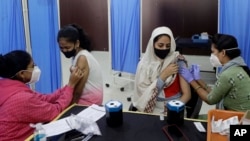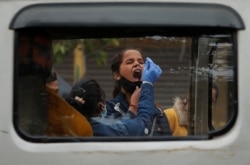An affordable COVID-19 vaccine developed by U.S. researchers and being produced in India could help address the vaccine inequity that is prolonging the pandemic as hundreds of millions in low-income countries wait for shots, according to public health experts.
India recently granted restricted emergency authorization to the vaccine, called Corbevax, which is based on a conventional, protein-based technology.
The Hyderabad-based company Biological E that collaborated with Texas Children's Hospital Center for Vaccine Development and Baylor College of Medicine in Houston, Texas, has said it will make 100 million doses starting next month and plans to deliver 1 billion doses globally. It already has a stockpile of 150 million doses.
There could still be time before Corbevax shots get into arms – Indian authorities have not yet added it to the shots being presently used in the country’s inoculation program.
The vaccine’s affordability is getting attention, though, as the raging omicron variant turns the spotlight on the abysmally low vaccination coverage in many countries and raises demands for booster shots in others.
“We think it'll be one of the lowest-cost vaccines out there -- a few dollars a dose. So certainly far less than the cost of mRNA vaccines or some of the other technologies, which again is a big advantage,” Dr. Peter Hotez, told VOA. He developed the vaccine along with Dr. Maria Elena Bottazzi. Both are co-directors at the Texas vaccine development center.
Its developers say the reason for the vaccine’s lower cost is that it is being shared patent-free without “any strings attached.” According to reports, it could be the cheapest vaccine available so far – less expensive than the AstraZeneca vaccine that has been the backbone of inoculation programs in India and several other developing countries.
Public health experts are optimistic that the vaccine could make a difference in Asian and African countries where vaccine coverage is abysmally low.
“It is going to be helpful in the overall global vaccination program. As we are still facing the challenge of variants, we will need more vaccines for many more people and as the West is preoccupied with giving booster after booster, the rest of the world is going to be kept waiting,” said K. Srinath Reddy, president of the Public Health Foundation of India.
“So, it is best to use this time-tested technology to produce more vaccines to ensure that more people in other countries also get the vaccine. It’s a simpler, safer technology, something that has been time-tested and adverse effects are very few in number though they do exist,” he said.
Health experts point out that variants of concern have emerged in countries with low vaccination coverage -- the delta variant originated in India last year when most people were not inoculated and the omicron variant was first identified in South Africa.
“If we ever hope to forestall the emergence of future variants, it means vaccinating the southern hemisphere, vaccinating Asia, Africa and Latin America as fast as possible, and that's the goal with our vaccine,” Hotez told VOA.
While world vaccine availability has improved with several new vaccines, cost still remains a limiting factor. Health experts point out that Astra Zeneca, whose COVID-19 vaccine was billed as the vaccine for the world, said in November that it will restrict its not-for-profit model only to poorer countries. Meanwhile, despite pressure, Moderna and Pfizer have not agreed to license their mRNA technology to developing countries, keeping it out of reach for much of the world.
Many African countries, including some of the continent's largest, such as Nigeria, have so far vaccinated fewer than 5% of their populations. The World Health Organization has been pushing for a 70% coverage for all countries by the middle of this year, but this could also be missed across many countries.
The developers of Corbevax say they are talking to manufacturers around the world.
“We now have relationships with other manufacturers in Indonesia, in Bangladesh -- we're working with a company that is building capacity -- in many locations in Africa, including Botswana and South Africa,” Bottazzi told VOA. “We have the hope that we also can transfer this technology to other countries like Vietnam, potentially also in Latin America.”
However, there are skeptics. While the Texas Children Hospital has said the vaccine was found to be safe and well-tolerated through Phase 3 clinical trials with more than 3,000 subjects, some caution that public data on its clinical efficacy is limited.
“It still has to be approved by the World Health Organization and we will also need more data to be convinced that it works against omicron,” according to Achal Prabhala at Access IBSA project, which campaigns for access to medicines in India, Brazil and South Africa.
“Moreover, Corbevax takes longer to produce, hence it is not really that easy to scale up. And the world needs billions of more doses,” he said.
Preliminary research has suggested that many of the existing vaccines do not work to prevent infection against omicron, though they reduce the severity of the disease.
Bottazzi said that studies of the vaccine’s efficacy against omicron are continuing. The vaccine is based on a conventional technology used to make the recombinant Hepatitis B vaccine that had been used for several decades.
Experts say that as countries begin to opt for vaccine combinations, Corbevax could help low- and middle-income countries expand their programs.
In India, the vaccine is in trial for booster doses and could also be used for export according to officials.
So far boosters will be rolled out starting Monday to health care workers and senior citizens with comorbidities with AstraZeneca and a locally developed vaccine.
However, public health experts expect Corbevax to play a role when the country widens the administration of booster shots -- calls for a third shot have been growing as the omicron variant spread rapidly in the country.
Megan Duzor contributed to this report.












